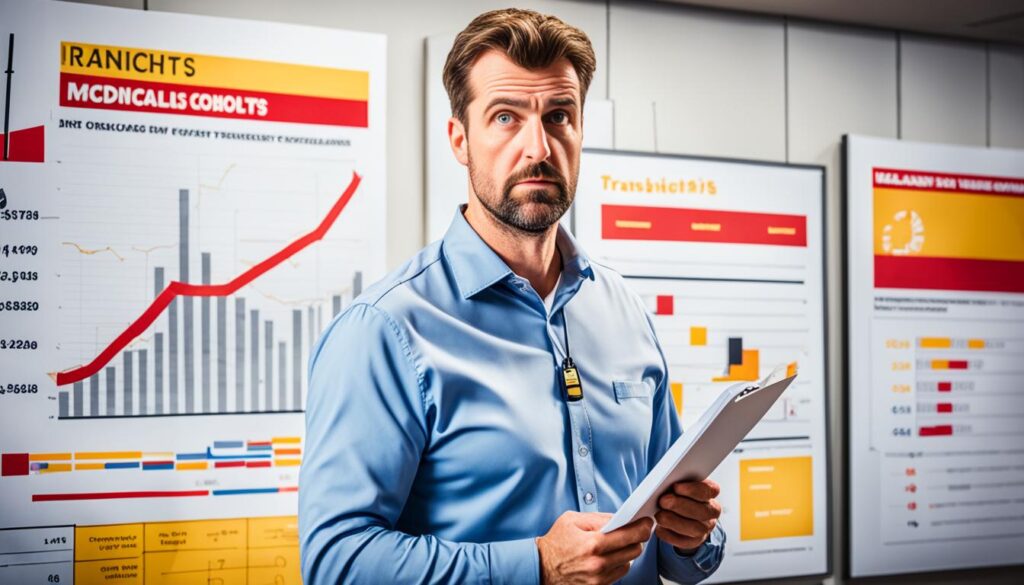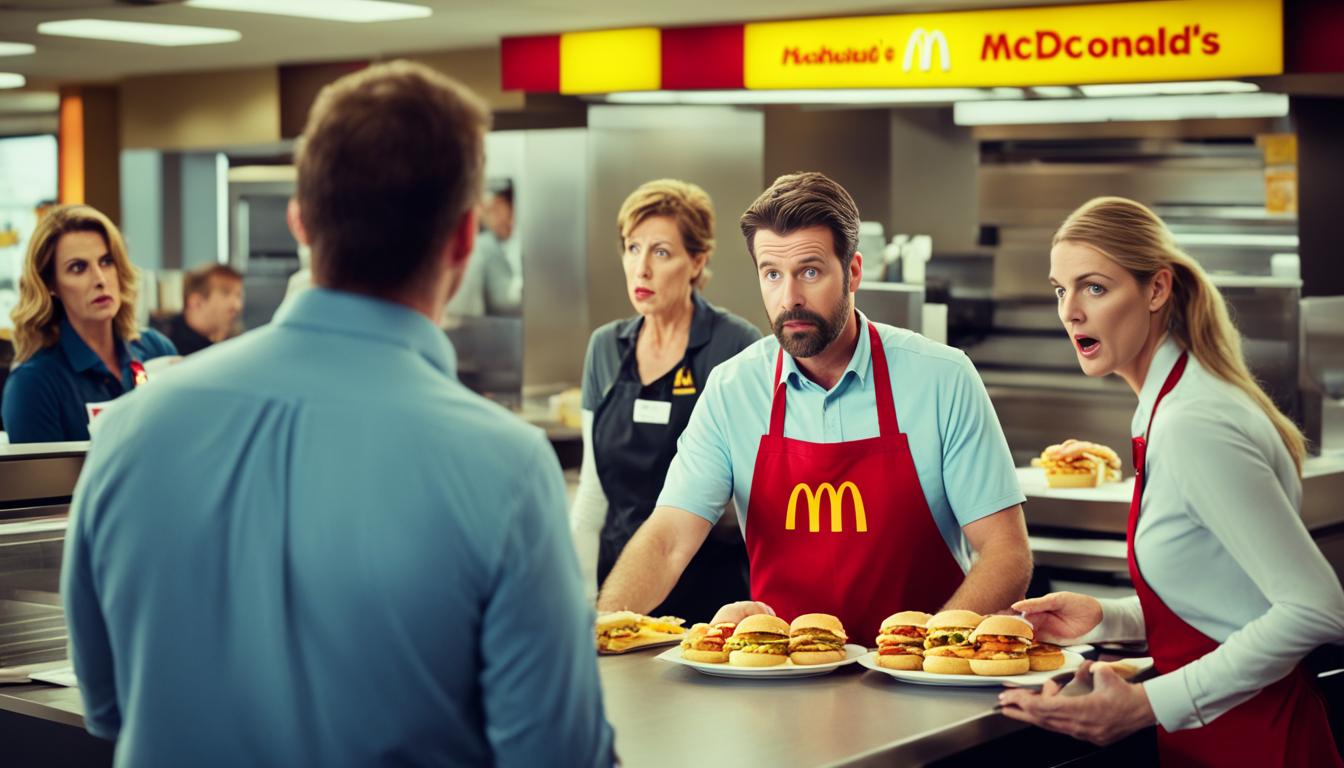Did you know that McDonald’s is planning to introduce a new grading system for its franchisees next year? This surprising development has sparked concern and frustration among McDonald’s franchise owners, who fear that the new rating system could have a negative impact on their operations and alienate their workers. With the introduction of the system, called Operations PACE (Performance and Customer Excellence), franchisees are worried about the timing and potential consequences of increased assessments on their businesses.
Key Takeaways:
- McDonald’s franchise owners are expressing concern over the company’s new grading system.
- The system, called Operations PACE, is set to be implemented in January 2023 and involves regular assessments per location.
- Franchisees fear that the new system may harm operations and alienate workers in a tight labor market.
- There are concerns that the new system could result in a less collaborative approach to operations, with harsher grading.
- McDonald’s defends the new assessment plan, stating that it is necessary to maintain their standards of excellence.
Concerns about the impact on employee morale and retention
As McDonald’s franchisees prepare for the implementation of the new rating system, there are growing concerns about its potential impact on employee morale and retention. In an already tight labor market, franchise owners are facing challenges in finding and retaining skilled workers. The introduction of the new system is expected to add further pressure, potentially decreasing morale and increasing turnover rates.
Franchisees are particularly worried about the system’s emphasis on identifying failures rather than fostering collaborative improvement. They fear that constantly highlighting failures may demotivate managers and staff, leading to a decline in overall employee morale. Instead of inspiring improvement, franchisees argue that constantly telling managers they have failed is more likely to lower morale and discourage innovative thinking.
The National Owners Association, an independent franchisee advocacy group, conducted a survey that sheds light on these concerns. The majority of participating franchise owners expressed doubts about the new rating system’s compatibility with McDonald’s “people-first” objectives. They believe that the system’s focus on inspections and grading, rather than collaborative improvement, may not align with the company’s commitment to prioritizing its people. This apprehension stems from a desire to maintain a positive work environment that empowers employees to excel and grow within the organization.
“The new rating system raises concerns about its potential negative impact on employee morale and retention. We need a collaborative approach that inspires our managers and staff to continuously improve rather than focusing solely on identifying failures,” said a franchise owner who participated in the survey.
Employee morale and retention are critical factors in maintaining a productive and efficient workforce. Lower morale can result in reduced productivity, decreased customer satisfaction, and a higher turnover rate. Franchisees recognize the importance of creating a positive work environment that nurtures and motivates their employees.
The franchisees’ concerns reflect a genuine dedication to upholding the values of the McDonald’s brand and creating a workplace culture that fosters growth and engagement. They believe that a more collaborative approach to improving operations, rather than focusing solely on failures, will yield better results in terms of employee morale, retention, and overall performance.
McDonald’s should carefully consider the feedback and concerns raised by its franchisees regarding the potential impact on employee morale and retention. By addressing these concerns and working together with franchise owners to find a solution that aligns with the company’s “people-first” objectives, McDonald’s can strive toward enhancing employee satisfaction, productivity, and long-term success.
Franchisee feedback and opposition to the new system
Feedback from McDonald’s franchisees regarding the new rating system has been met with significant opposition. The National Owners Association conducted an internal survey among its members, revealing widespread dissatisfaction with the new grading curriculum. Only 3% of respondents felt that the system accurately reflected daily operations, while over 80% expressed concerns that it would not support the company’s “people-first” objectives. This feedback highlights the franchisees’ reservations about the effectiveness and alignment of the new rating system.
Another survey, conducted by sell-side firm Kalinowski Equity Research, further reinforced the opposition to the new system. Respondents voiced their belief that the system would hinder sales and increase employee turnover. This sentiment underlines the apprehension among franchisees about the potential negative impact the new rating system could have on their businesses. The survey also identified a historically low level of satisfaction in the corporate-franchisee relationship, ranking it the third-worst score ever recorded.
“The new grading curriculum fails to accurately reflect our operations and undermines our commitment to a ‘people-first’ culture. It will only deter sales and exacerbate the challenges we already face in retaining employees.”
– McDonald’s franchisee
The franchisee feedback showcases genuine concerns about the potential consequences and effectiveness of the new rating system. It highlights the need for careful consideration and adjustment to address the ongoing opposition and maintain a constructive relationship between McDonald’s and its franchisees.
Franchisee Feedback Survey Results
| Perception | Percentage of Respondents |
|---|---|
| The new grading curriculum accurately reflects operations | 3% |
| The new grading curriculum will be helpful to the company’s “people-first” objectives | 20% |
| The new grading curriculum will not be helpful to the company’s “people-first” objectives | 80% |
Note: The survey conducted by the National Owners Association featured a total of 500 respondents.
The survey conducted by Kalinowski Equity Research indicated the following:
- The new system will hinder sales.
- The new system will lead to increased employee turnover.
The franchisee feedback and surveys convey the opposition and concerns expressed by McDonald’s franchisees regarding the new rating system. These insights highlight the importance of addressing the franchisees’ apprehensions and finding solutions that foster collaboration and support mutual objectives.
McDonald’s defense of the new assessment plan
McDonald’s stands firmly behind its new assessment plan, emphasizing the importance of maintaining their standards of excellence and delivering a seamless customer experience. The company asserts that the system was developed in collaboration with franchisees, ensuring that their perspectives and insights were considered during its creation.
One of the key features of the new assessment plan is the provision of tailored support and coaching to McDonald’s restaurants. Franchisees will have access to personalized resources that are designed to help them improve performance and drive sales, profitability, and guest counts. This individualized approach aims to address the specific needs and challenges faced by each restaurant, enabling them to achieve optimal results.
In order to facilitate a smooth transition to the new system, McDonald’s has opted to offer optional learning visits in 2022. This will give franchisees the opportunity to familiarize themselves with the assessment framework and make any necessary adjustments to their operations. McDonald’s recognizes the importance of providing adequate time for restaurants to adapt and ensures that they are adequately supported throughout this transitional period.
“Our new assessment plan reflects our commitment to continuous improvement and providing the best possible experience for our customers. By working closely with our franchisees, we have created a system that not only upholds our high standards but also offers tailored support for their individual needs. We believe that this new approach will drive better performance and help our restaurants thrive in today’s competitive landscape.” – McDonald’s spokesperson
By defending the new assessment plan, McDonald’s highlights its dedication to maintaining excellence across its franchise network. The company’s emphasis on collaboration and tailored support aims to empower franchisees and enable them to overcome challenges and achieve success in an evolving industry.

Industry challenges and the labor market
The challenges faced by McDonald’s and other fast-food companies extend beyond the new rating system. The industry is currently grappling with various challenges that impact operations and workforce management. Two key challenges are labor costs and the highly competitive labor market.
Labor Costs
McDonald’s franchisees, like many others in the industry, have been experiencing an increase in labor costs. Factors such as rising minimum wages, mandated benefits, and increased costs of recruitment and training have contributed to this upward trend. To offset these costs, franchise owners have had to raise prices along with wages, putting pressure on both consumers and the franchisees themselves.
Intense Competition in the Labor Market
The labor market for the fast-food industry is highly competitive, characterized by a shortage of available workers. With the rise of gig economy jobs and a shift in priorities among job seekers, attracting and retaining employees has become increasingly challenging. Franchisees are not only competing with other fast-food chains but also with other industries that offer enticing benefits and opportunities for advancement.
A Growing Union Push
Adding to the challenges faced by McDonald’s and its franchisees is the growing union push in the food sector. Workers in the industry are advocating for better benefits, improved working conditions, and increased job security. Unionization efforts by employees add complexity to labor management and may have implications for franchise operations and costs.

The combination of these industry challenges and the current labor shortage makes the timing of the new rating system concerning for franchisees. They fear that the system’s implementation may exacerbate existing difficulties in attracting and retaining employees, further straining operations and profitability.
| Industry Challenges | Implications |
|---|---|
| Labor costs | Raising prices, impacting profitability |
| Intense competition in the labor market | Difficulty attracting and retaining employees |
| A growing union push | Increase in labor-related demands and potential impact on operations |
Conclusion
The new rating system introduced by McDonald’s has raised significant concerns among franchisees. Many franchise owners worry that the system’s focus on inspections and grading, rather than collaborative improvement, will harm operations, demotivate managers, and alienate workers.
The franchisee feedback has been largely negative, with surveys indicating a lack of confidence in the accuracy of the grading system and its alignment with the company’s “people-first” objectives. McDonald’s, on the other hand, defends the new assessment plan, emphasizing its collaboration with franchisees and the support it offers to improve performance.
As the implementation date approaches, the impact of the new rating system on employee morale and retention, as well as overall operations, remains a significant concern for McDonald’s franchisees. The franchisees’ concerns must be addressed through transparent communication, ongoing collaboration, and an agile approach to operational improvements. By working together, McDonald’s and its franchisees can find a solution that maintains high standards and promotes a positive work environment.
FAQ
What is the new rating system introduced by McDonald’s?
How often will assessors visit each McDonald’s location under the new rating system?
What concerns do franchisees have about the new rating system?
Is there a fear that the new rating system will negatively impact employee morale and retention?
What do surveys indicate about franchisee feedback and opposition to the new rating system?
How does McDonald’s defend the new assessment plan?
What are the industry challenges and labor market factors affecting McDonald’s franchisees?
What is the impact of the new rating system on employee morale, retention, and overall operations?
What is McDonald’s stance on the concerns raised by franchisees?
When will the optional learning visits for the new rating system be offered?
Source Links
- https://www.cnbc.com/2023/12/05/stack-ranking-ex-amazon-exec-explains-the-performance-review-system.html
- https://www.cnbc.com/2022/05/11/mcdonalds-franchisees-worry-new-grading-system-will-alienate-workers.html
- https://www.linkedin.com/pulse/mcdonalds-fires-ceo-over-relationship-employee-andrew-ross-sorkin










